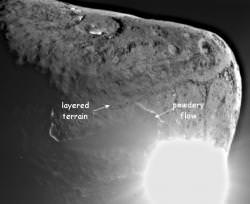When Deep Impact smashed into Comet Tempel 1, it did its job well… too well. Yes, it did carve out a crater on the surface of the comet, releasing a plume of debris visible from here on Earth. But there was a problem. The impact released so much debris into space that the spacecraft couldn’t see the surface of the comet before it sped by. No problem, there’s another handy spacecraft out there, with all the right equipment and nothing to do: Stardust.
Why wasn’t Deep Impact able to see the crater it had just helped carve out of Comet Tempel 1? That was all part of the plan. Researchers wanted to be able to measure the cloud of particles ejected into space after the impact. In order to do that, they needed the flyby spacecraft to pass the comet moments after the impact; to get the best view of the dust. Deep Impact was traveling so quickly that it just swept past and back out into space.
But what size and depth of crater was left behind?
That’s still a mystery that astronomers want solved. Fortunately, NASA’s Stardust spacecraft is in an orbit that will let it rendezvous with Comet Tempel 1 in the future. This was the spacecraft that flew through the tail of Comet Wild 2 in 2004, capturing particles and returning them back to Earth. Stardust released its payload to return to Earth safely, but it remained in space, looking for another task. The spacecraft will be given a new trajectory, burning up some of its remaining fuel.
Obviously, recycling a spacecraft like this can be done at a huge discount to sending a new vehicle up. You just have the operating costs for people; you’re looking at 15% the cost of doing a full mission.
Stardust will arrive in 2011, almost exactly one-cometary year after Deep Impact did the damage in the first place. The dust cloud will have dissipated away into space, and Stardust will have a good view down into the crater. Scientists will also learn what kind kind of changes the Sun will have on the new wound.
The original Deep Impact spacecraft is going to be recycled too. NASA has plans to fly it past Comet Boethin in December 2008 to examine that comet’s nucleus. It will even be tasked to help search for extrasolar planets, by using its sensitive instruments to watch for planets dimming stars as they pass in front.
Original Source: Science@NASA

